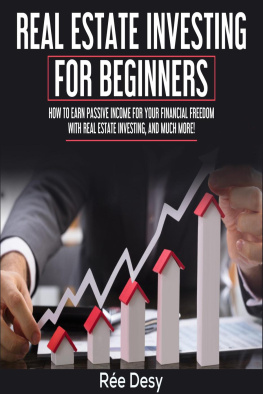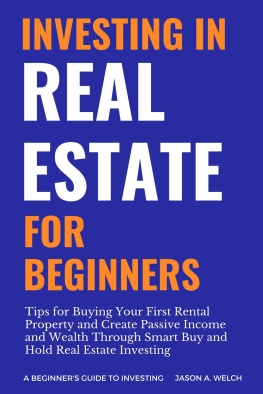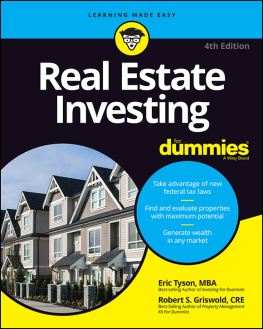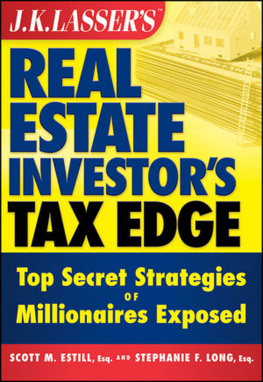THE McGRAW-HILL 36-Hour Course
REAL ESTATE INVESTING
SECOND EDITION
Other books in The McGraw-Hill 36-Hour Course series:
The McGraw-Hill 36-Hour Course: Accounting
The McGraw-Hill 36-Hour Course: Business Writing and Communication, 2E
The McGraw-Hill 36-Hour Course: Finance for Nonfinancial Managers
The McGraw-Hill 36-Hour Course: Operations Management
The McGraw-Hill 36-Hour Course: Organizational Development
The McGraw-Hill 36-Hour Course: Product Development
The McGraw-Hill 36-Hour Course: Project Management, 2E
The McGraw-Hill 36-Hour Course: Six Sigma
THE McGRAW-HILL 36-Hour Course
REAL ESTATE INVESTING
SECOND EDITION
Jack Cummings


Copyright 2010 by The Jack Cummings. All rights reserved. Except as permitted under the United States Copyright Act of 1976, no part of this publication may be reproduced or distributed in any form or by any means, or stored in a database or retrieval system, without the prior written permission of the publisher.
ISBN: 978-0-07-174376-1
MHID: 0-07-174376-6
The material in this eBook also appears in the print version of this title: ISBN: 978-0-07-174082-1, MHID: 0-07-174082-1.
All trademarks are trademarks of their respective owners. Rather than put a trademark symbol after every occurrence of a trademarked name, we use names in an editorial fashion only, and to the benefit of the trademark owner, with no intention of infringement of the trademark. Where such designations appear in this book, they have been printed with initial caps.
McGraw-Hill eBooks are available at special quantity discounts to use as premiums and sales promotions, or for use in corporate training programs. To contact a representative please e-mail us at bulksales@mcgraw-hill.com.
This publication is designed to provide accurate and authoritative information in regard to the subject matter covered. It is sold with the understanding that neither the author nor the publisher is engaged in rendering legal, accounting, securities trading, or other professional services. If legal advice or other expert assistance is required, the services of a competent professional person should be sought.
From a Declaration of Principles Jointly Adopted by a Committee of the
American Bar Association and a Committee of Publishers and Associations
TERMS OF USE
This is a copyrighted work and The McGraw-Hill Companies, Inc. (McGraw-Hill) and its licensors reserve all rights in and to the work. Use of this work is subject to these terms. Except as permitted under the Copyright Act of 1976 and the right to store and retrieve one copy of the work, you may not decompile, disassemble, reverse engineer, reproduce, modify, create derivative works based upon, transmit, distribute, disseminate, sell, publish or sublicense the work or any part of it without McGraw-Hills prior consent. You may use the work for your own noncommercial and personal use; any other use of the work is strictly prohibited. Your right to use the work may be terminated if you fail to comply with these terms.
THE WORK IS PROVIDED AS IS. McGRAW-HILL AND ITS LICENSORS MAKE NO GUARANTEES OR WARRANTIES AS TO THE ACCURACY, ADEQUACY OR COMPLETENESS OF OR RESULTS TO BE OBTAINED FROM USING THE WORK, INCLUDING ANY INFORMATION THAT CAN BE ACCESSED THROUGH THE WORK VIA HYPERLINK OR OTHERWISE, AND EXPRESSLY DISCLAIM ANY WARRANTY, EXPRESS OR IMPLIED, INCLUDING BUT NOT LIMITED TO IMPLIED WARRANTIES OF MERCHANTABILITY OR FITNESS FOR A PARTICULAR PURPOSE. McGraw-Hill and its licensors do not warrant or guarantee that the functions contained in the work will meet your requirements or that its operation will be uninterrupted or error free. Neither McGraw-Hill nor its licensors shall be liable to you or anyone else for any inaccuracy, error or omission, regardless of cause, in the work or for any damages resulting therefrom. McGraw-Hill has no responsibility for the content of any information accessed through the work. Under no circumstances shall McGraw-Hill and/or its licensors be liable for any indirect, incidental, special, punitive, consequential or similar damages that result from the use of or inability to use the work, even if any of them has been advised of the possibility of such damages. This limitation of liability shall apply to any claim or cause whatsoever whether such claim or cause arises in contract, tort or otherwise.
CONTENTS
ACKNOWLEDGMENTS
When a writer sits down to write a book, there is an anticipation that a love affair is about to start, and no matter how tedious the work may be, the affection for the manuscript is steady, virtuous, and faithful. That love affair occasionally is renewed when the audienceand therefore the publisherdemands a new edition. Like all love affairs, the second time around can be far more demanding than the first. So it has been with this edition. Demanding because of the need to improve, to be fresh and up-to-date, and to deliver more information that is helpful and informative to the books readers.
When the work to attain those goals is completed, there is a period of mixed emotionan elation that the newly revised child is born, yet a sadness that the love affair has ended, and worst of all, despair that until the next book is begun, the writer is out of work, a feeling that many writers and actors understand very well.
When finally asked to dedicate the book to someone, there is a moment when all writers scramble to find the person they should acknowledge as a primary driving force for the book, while at the same time not prematurely ending offers for new books, and certainly not stepping on toes, hurting feelings, or cutting off possible loan sources when times might get tough.
Fortunately, for this book at least, this dedication is made with a clear conscience and sincere thanks. Many years ago, my first editor for the first book I was to sell was a young editor at Prentice Hall who called me on the phone one day to ask me if I would be interested in writing a book. That book turned out to be The Real Estate Financing Manual, and that man was to teach me a great deal about the writing profession, and about myself. That book is as of 2008 in its ninth edition, and my sincere hope is that there will be many more to come.
It is because of his continued faith in me that I dedicate this book to my good friend and first editor, Ted Nardin.
INTRODUCTION
We are in a historic time of financial upheaval. This is the time of chaos and opportunity. Each of these produces the other, and here we are: the start of the decade is well behind us, and both chaos and opportunity still exist. At the time of this writing the real estate marketplace has undergone the greatest drop in prices you may ever see. Yet I and all my investor insider friends are excited about thisthough the excitement is not without mixed emotions. Opportunities are popping up all around us, while at the same time many people are losing their jobs and their homes and are frustrated with what is happening to their lives. And who is to blame? Or is that really important now? The important thing for all of us is to realize the market does rise, fall, and rise again. Lessons of what we should not have done hopefully will protect us from making similar mistakes in the future. What we need to do is to realize that we can now prosper in this chaos.
Next page








